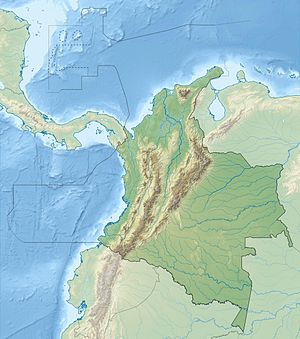Alberto Lleras dam
| Alberto Lleras dam - Guavio reservoir - Guavio hydropower plant |
|||||||||||
|---|---|---|---|---|---|---|---|---|---|---|---|
| Guavio reservoir | |||||||||||
|
|||||||||||
|
|
|||||||||||
| Coordinates | 4 ° 43 '34 " N , 73 ° 28' 59" W | ||||||||||
| Data on the structure | |||||||||||
| Construction time: | 1980-1989 | ||||||||||
| Height above foundation level : | 243 m | ||||||||||
| Height above the river bed : | 232 m | ||||||||||
| Height of the structure crown: | 249 m | ||||||||||
| Building volume: | 17th 100 000 m³ | ||||||||||
| Crown length: | 390 m | ||||||||||
| Power plant output: | 1213 MW | ||||||||||
| Operator: | Empresa de Energía de Bogotá (EEB) | ||||||||||
| Data on the reservoir | |||||||||||
| Altitude (at congestion destination ) | 1630 m | ||||||||||
| Water surface | 13.44 km² | ||||||||||
| Reservoir length | 16 km | ||||||||||
| Storage space | 1047 million m³ | ||||||||||
| Catchment area | 1 200 km² | ||||||||||
| Design flood : | 4200 m³ / s | ||||||||||
| View of the dam | |||||||||||
The Alberto Lleras dam (Spanish Represa Alberto Lleras , sometimes also referred to as the "Guavio dam") is one of the world's largest dams and is located in central Colombia in the department of Cundinamarca . The $ 1.3 billion project came about in the late 1990s with financial support from the World Bank and the Inter-American Development Bank . The dam was named after Alberto Lleras Camargo , a former president of the country (1945-1946). The dam is located 70 kilometers east of the capital Bogotá in the Colombian Eastern Cordillera on the Río Guavio in the Orinoco catchment area . The builder and owner of the dam built to generate electricity is Empresa de Energía de Bogotá (EEB).
dam
The dam, completed in 1989, dams the Río Guavio over a length of 16 km. It consists of a 243 m high rock embankment dam . The crown length is 390 m. The building volume is 17.755 million m³. The flood relief system consists of two tunnels, 427 m and 461 m long, each of which can discharge 2100 m³ / s.
Reservoir
The Guavio reservoir (Spanish: Embalse del Guavio ) has a water surface of 1344 ha. The reservoir target is around 1630 m . The lowest water level for the operation of the power plant is 1598 m . The storage volume is 1047 million m³, the usable storage space is 787 million m³. The reservoir is fed by the Río Gachetá , Río Murca and Río Santa Barbara . Furthermore, water from the upper reaches of the two nearby rivers Río Chivor and Río Batatas is fed to the reservoir via a 2190 m and 2330 m long underground pipeline. The municipality of Gachalá is located on the southern shore of the lake . The natural catchment area covers an area of around 1200 km².
Hydroelectric power plant
The water is diverted from the reservoir via an inlet structure . The water is fed through an approximately 13.5 km long tunnel to a compensation chamber (319 m long; diameter: 8.4 m). Via a water lock (545 m) and a 1.4 km long pressure tunnel reaches the water finally located underground hydroelectric power plant Guavio (span. Central hidroeléctrica del Guavio ⊙ ). The cavern power plant has a 234 m long, 17 m wide and 35 m high machine room as well as a 201 m long, 14 m wide and 21 m high chamber for the transformers. The engine room is designed for 8 units. However, only 5 units were installed. Each unit has a Pelton turbine with an output of 242.6 MW. The total installed capacity is thus 1213 MW. The average annual energy production is 5890 GWh. The height of fall is 1050 m. Below the power station, the water is returned to the Río Guavio via a 5.3 km long drainage tunnel ( ⊙ ). The hydropower plant was commissioned in 1990.
![]() Map with all coordinates: OSM | WikiMap
Map with all coordinates: OSM | WikiMap
landslide
There was a serious accident while the dam was being built. A landslide spilled between 150 and 200 workers. During the rescue work, helpers were also buried by another landslide. They were buried when several massive rock slides totaling 60,000 cubic meters of earth fell on them on the evening of July 28, 1983. 138 workers were buried inside and an additional 40 workers were killed when the buses they were sitting in were trapped in falling rocks. About 20 residents who supported the work in one way or another were also killed in the tunnels. Only half of the deaths were recovered.
See also
- List of the largest dams on earth
- List of the largest reservoirs on earth
- List of power plants in Colombia
- List of dams in the world (Colombia)
Individual evidence
- ↑ a b c d e Impactos Socioambientales y Posible Afectación de Derechos derivada de la Generación Hidroeléctrica en Colombia (PDF, 2.7 MB) Defensoría del Pueblo, Colombia. August 2017. Archived from the original on December 9, 2018. Info: The archive link has been inserted automatically and has not yet been checked. Please check the original and archive link according to the instructions and then remove this notice. Retrieved September 22, 2019.
- ↑ Colombia Dam Disaster of July 28, 1983: 'The Night the Lights Went Dark' on 200 Casual Workers industriall-union.org, accessed on June 5, 2019 (English)
Web links
- Photos on page 10 (PDF file; 1.83 MB)
- Alberto Lleras dam. In: Structurae
- The greatest and highest ( memento of March 14, 2007 in the Internet Archive )
- HISTORY OF ROCKFILL DAM CONSTRUCTION (English)


